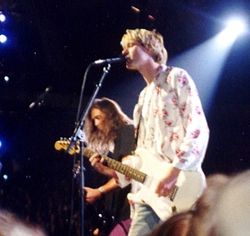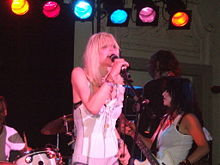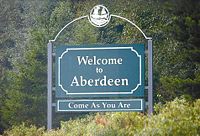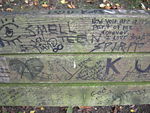Kurt Cobain
| Kurt Cobain | |
|---|---|
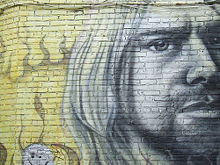 Tribute to Kurt Cobain in a Chicago alley
| |
| Background information | |
| Birth name | Kurt Donald Cobain |
| Born | February 20 1967 Aberdeen, Washington, USA |
| Died | c. April 5 1994 (aged 27) Seattle, Washington, U.S. |
| Genre(s) | Alternative rock Grunge |
| Occupation(s) | Musician, Songwriter |
| Instrument(s) | Vocals Guitar |
| Years active | 1987–1994 |
| Associated acts | Nirvana Fecal Matter |
| Notable instrument(s) | |
| Electric guitar | |
Kurt Donald Cobain (February 20, 1967 – c. April 5, 1994) was an American musician who served as lead singer, guitarist, and songwriter for the Seattle-based rock band Nirvana.
Cobain formed Nirvana in 1987, with Krist Novoselic. Within two years, the band became a fixture of the burgeoning Seattle grunge scene. In 1991, the release of Nirvana's hit, "Smells Like Teen Spirit" marked the beginning of a dramatic shift of popular rock music away from the dominant genres of the 1980s, toward grunge and alternative rock. The music journalism media eventually labeled Cobain a "spokesman" for Generation X.
Cobain came from a troubled family, and suffered the divorce of his parents when just seven. During the last years of his life, Cobain struggled with drug addiction and dealing with the media attention surrounding him and his wife, Courtney Love. On April 8, 1994, Cobain was found dead in his home in Seattle, the victim of an apparently self-inflicted shotgun wound to the head. In ensuing years, the circumstances of his death became a topic of fascination and debate.
Life and career
Early life
Kurt Cobain was born to Donald and Wendy Cobain on February 20, 1967, in Aberdeen, Washington, and spent his first six months living in the village of Hoquiam, Washington, before the family moved to Aberdeen. He began developing an interest in music early in his life.
Cobain's life changed at the age of seven, when his parents divorced in 1975, an event which he later cited as having a profound impact on his life. His mother noted that his personality changed dramatically, with Cobain becoming more withdrawn. In a 1993 interview, Cobain said, "I remember feeling ashamed, for some reason. I was ashamed of my parents."[1] After a year spent living with his mother following the divorce, Cobain moved to Montesano, Washington, to live with his father, but after a few years his youthful rebellion became so intense that he found himself being shuffled between friends and family.
At school, Cobain took little interest in sports. At his father's insistence, he joined the junior high wrestling team. While he was good at the sport, he also despised it. Later, his father signed him up for a local baseball league, where Cobain would intentionally strike out to avoid having to play. Instead, Cobain focused on his art courses.
Cobain was friends with a gay student at his school, sometimes suffering bullying at the hands of other students as a result. That friendship led some to believe that he himself was gay. In one of his personal journals, Cobain wrote, "I am not gay, although I wish I were, just to piss off homophobes."[2] Cobain eventually found escape through the thriving Pacific Northwest punk scene, going to punk rock shows in Seattle. Eventually, he began frequenting the practice space of fellow Montesano musicians, the Melvins.
In the middle of tenth grade, Cobain moved back to live with his mother in Aberdeen. Two weeks before his scheduled graduation, however, he dropped out of high school after realizing that he did not have enough credits to graduate. His mother gave him a choice: either get a job or leave. After a week or so, Cobain found his clothes and other belongings packed away in boxes. Forced out of his mother's home, he stayed at friends' houses and sneaked into his mother's basement occasionally.
In late 1986, Cobain moved into the first house he lived in alone and paid his rent by working at a coastal resort 20 miles from Aberdeen. At the same time, he traveled frequently to Olympia, Washington, to check out rock shows.
Nirvana
For his fourteenth birthday, Cobain's uncle had given him the option of a guitar or a bicycle as a gift; Cobain chose the guitar. He started learning songs such as AC/DC's "Back in Black" and The Cars' "My Best Friend's Girl." He soon began working on his own songs.
In high school, Cobain rarely found anyone with whom he could jam. While hanging out at the Melvins' practice space, he met Krist Novoselic, a fellow devotee of punk rock. Novoselic's mother owned a hair salon, and Cobain and Novoselic would occasionally practice in the upstairs room. Later, Cobain convinced Novoselic to create a band with him, and this formed the beginnings of Nirvana.
During their first few years playing together, Novoselic and Cobain were hosts to a rotating list of drummers. Eventually, the band hired on Chad Channing, with whom Nirvana recorded the album Bleach, released on Sub Pop Records in 1989. Cobain, however, became dissatisfied with Channing's style, leading the band to seek out a replacement, settling eventually on Dave Grohl. With Grohl, the band found its greatest success via their 1991 major-label debut, Nevermind.
Cobain struggled to reconcile the massive success of Nirvana with his underground roots. He also felt persecuted by the media, harboring resentment for people who claimed to be fans of the band, but who, he felt, completely missed the point of the band's message.
Marriage
Courtney Love first saw Cobain perform in 1989, at a show in Portland, Oregon. The pair talked briefly after the show and Love developed a crush on him. According to journalist Everett True, the couple was formally introduced at an L7/Butthole Surfers concert in Los Angeles in May 1991. In the weeks that followed, after learning from Dave Grohl that she and Cobain shared mutual crushes, Love began pursuing Cobain. After a few weeks of on-again, off-again courtship in the fall of 1991, the two found themselves together on a regular basis. Besides their emotional and physical attraction, the couple reportedly also often bonded through drug use.[3]
Love was unpopular with some Nirvana fans. Her harshest critics said she was merely using him as a vehicle to make herself famous. Some compared Cobain to John Lennon while Love was equated with Yoko Ono.
In a 1992 article in Vanity Fair, Love admitted to using heroin while unknowingly pregnant. She later claimed that Vanity Fair had misquoted her, but her admission created controversy for the couple. While Cobain and Love's romance had always been something of a media attraction, the couple found themselves hounded by tabloid reporters after the article was published. The Los Angeles County Department of Children's Services took the Cobains to court, claiming that the couple's drug usage made them unfit parents. Two-week-old Frances Bean Cobain was ordered by the judge to be taken from their custody and placed with Courtney's sister, Jamie. Kurt and Courtney then obtained custody after several weeks, but had to submit to urine tests and a regular visit from a social worker. After months of legal wrangling, the couple were eventually granted full custody of their daughter.
Drug addiction
Cobain's first drug experience was reportedly with marijuana in 1980, at age 13. He tried heroin sometime in 1986, administered by a local drug dealer in Tacoma, Washington, who had previously been supplying him with percodan. Cobain used heroin sporadically for several years, and by the end of 1990, his use had developed into a full-fledged addiction. He claimed that he was "determined to get a habit" as a way to self-medicate his stomach condition. Related Cobain, "It started with three days in a row of doing heroin and I don't have a stomach pain. That was such a relief."[4]
His heroin use eventually began affecting the band's success, with Cobain passing out during photo shoots. Cobain's addiction only worsened as the years progressed. He made his first attempt at rehab in early 1992, not long after he and Love discovered they were going to become parents. Immediately after he left rehab, Nirvana embarked on its Australian tour, with Cobain appearing pale and gaunt while suffering through withdrawal. Not long after returning home, Cobain's heroin use resumed.
Prior to a performance at the New Music Seminar in New York City in July 1993, Cobain suffered a heroin overdose. Rather than calling for an ambulance, Love injected Cobain with illegally acquired naloxone to bring him out of his unconscious state. Cobain proceeded to perform with Nirvana, giving the public no indication that anything out of the ordinary had taken place.
Final weeks and death
Following a tour stop at Terminal Eins in Munich, Germany, on March 1, 1994, Cobain was diagnosed with bronchitis and severe laryngitis. He flew to Rome the next day for medical treatment, and was joined there by his wife on March 3. The next morning, Love awoke to find that Cobain had overdosed on a combination of champagne and Rohypnol. Cobain was immediately rushed to the hospital, and spent the rest of the day unconscious. After five days in the hospital, he was released and returned to Seattle.
On March 18, Love phoned police to inform them that Cobain was suicidal and had locked himself in a room with a gun. Police arrived and confiscated several guns and a bottle of pills from Cobain, who insisted that he was not suicidal and had locked himself in the room to hide from Love.
On April 8, 1994, Cobain's body was discovered in the spare room above the garage at his Lake Washington home by Veca Electric employee Gary Smith. Apart from a minor amount of blood coming out of Cobain's ear, Smith reported seeing no visible signs of trauma, and initially believed that Cobain was asleep. Smith found what he thought might be a suicide note with a pen stuck through it beneath an overturned flowerpot. A shotgun was found resting on Cobain's chest. Cobain's death certificate stated that his death was a result of a "contact perforating shotgun wound to the head," and concluded his death a suicide. The report estimated Cobain to have died on April 5.
On April 10, a public vigil was held for Cobain at a park at Seattle Center which drew approximately 7,000 mourners. Prerecorded messages by Krist Novoselic and Courtney Love were played. Love read portions of Cobain's suicide note to the crowd and broke down, crying and chastising Cobain. Near the end of the vigil, Love arrived at the park and distributed some of Cobain's clothing to those who still remained. Cobain's body was cremated.
Musical influences
Cobain was a devoted champion of early alternative rock acts. His interest in the underground started when Buzz Osborne of the Melvins let him borrow a tape with songs by punk bands such as Black Flag, Flipper, and Millions of Dead Cops. He would often refer to his favorite bands in interviews, often placing a greater importance on the bands that influenced him than on his own music.
Cobain also noted the influence of the Pixies, and commented that "Smells Like Teen Spirit" bore some similarities to their sound. Cobain told Melody Maker in 1992, that hearing Surfer Rosa for the first time convinced him to abandon his more Black Flag-influenced songwriting in favor of the "Iggy Pop/Aerosmith" type songwriting that appeared on Nevermind.
The Beatles were an early and important musical influence on Cobain. He expressed a particular fondness for John Lennon, whom he called his "idol" in his journals. Cobain once related that he wrote "About a Girl" after spending three hours listening to Meet the Beatles! He was heavily influenced by punk rock and hardcore punk, and often credited bands such as Black Flag and the Sex Pistols for his artistic style and attitude.
Nirvana's early style was also influenced by the major rock bands of the 1970s, including Led Zeppelin, Black Sabbath, Kiss, and Neil Young. In its early days, Nirvana made a habit of regularly playing cover songs by those bands.
Legacy
In 2005, a sign was put up in Aberdeen, Washington, that read, "Welcome to Aberdeen—Come As You Are" as a tribute to Cobain. The sign was paid for and created by the Kurt Cobain Memorial Committee, a non-profit organization created in May 2004, to honor Cobain. The Committee also planned to create a Kurt Cobain Memorial Park and a youth center in Aberdeen.
As Cobain has no grave site, many Nirvana fans visit Viretta Park, near Cobain's former Lake Washington home, to pay tribute. On the anniversary of his death, fans gather in the park to celebrate his life and memory. In the years following his death, Cobain is now often remembered as one of the most iconic rock musicians in the history of alternative music.
Gus Van Sant based his 2005 movie, Last Days, on what might have happened in the final hours of Cobain's life. Several biographies of Cobain have also emerged.
Notes
ReferencesISBN links support NWE through referral fees
- Azerrad, Michael. Come as You Are: The Story of Nirvana. New York: Doubleday, 1994. ISBN 0-385-47199-8.
- Cobain, Kurt. Journals. New York: Riverhead Books, 2002. ISBN 9781573222327.
- Cross, Charles. Heavier Than Heaven: A Biography of Kurt Cobain. New York: Hyperion, 2001. ISBN 0-7868-8402-9.
- Kitts, Jeff, et al. Guitar World Presents Nirvana and the Grunge Revolution. Milwaukee,WI: Hal Leonard, 1998. ISBN 0-79-35900-6X.
External links
All links retrieved June 16, 2018.
- Kurt & Courtney: No Nirvana at The Smoking Gun www.thesmokinggun.com.
Credits
New World Encyclopedia writers and editors rewrote and completed the Wikipedia article in accordance with New World Encyclopedia standards. This article abides by terms of the Creative Commons CC-by-sa 3.0 License (CC-by-sa), which may be used and disseminated with proper attribution. Credit is due under the terms of this license that can reference both the New World Encyclopedia contributors and the selfless volunteer contributors of the Wikimedia Foundation. To cite this article click here for a list of acceptable citing formats.The history of earlier contributions by wikipedians is accessible to researchers here:
The history of this article since it was imported to New World Encyclopedia:
Note: Some restrictions may apply to use of individual images which are separately licensed.
